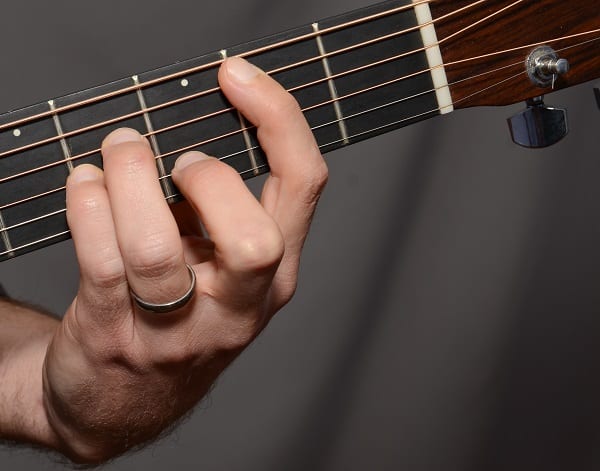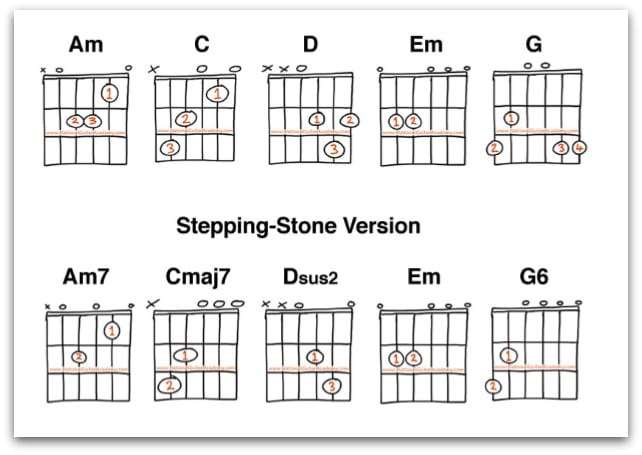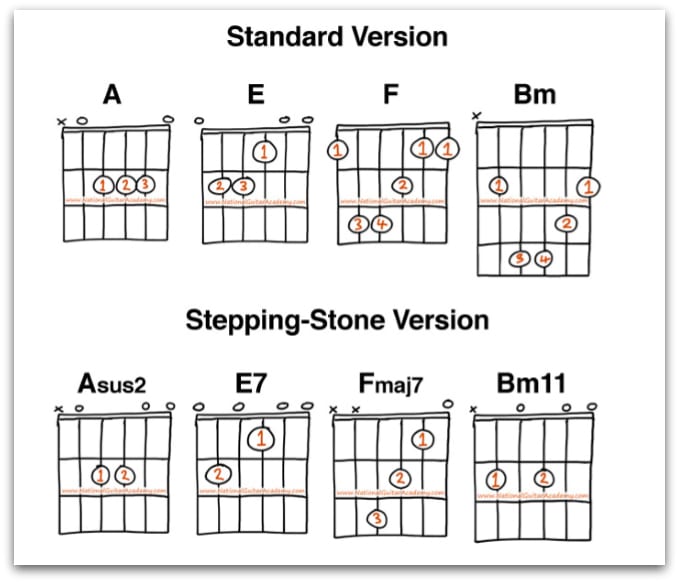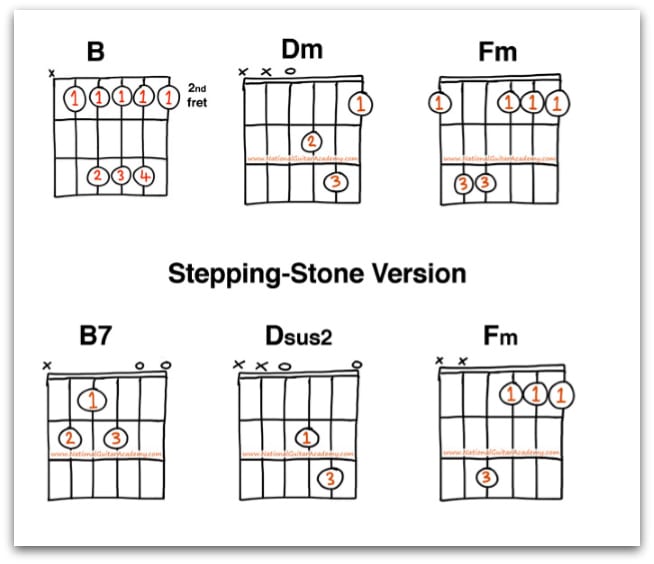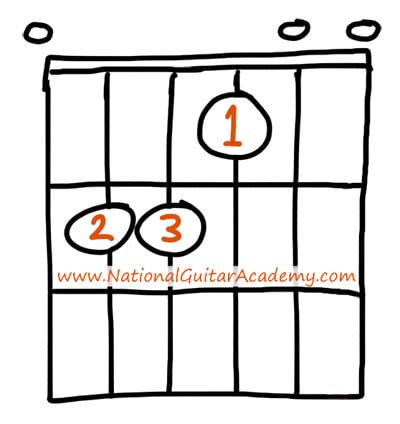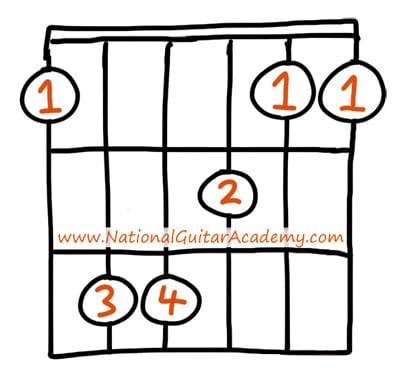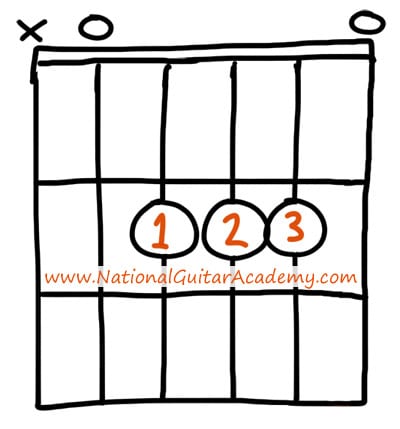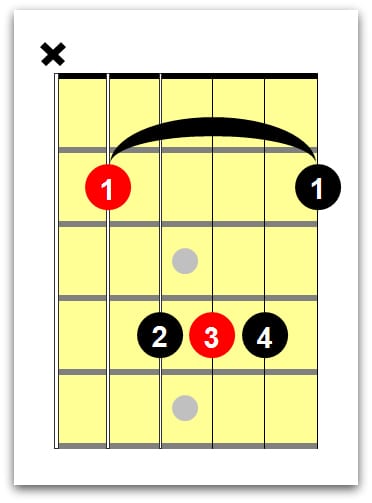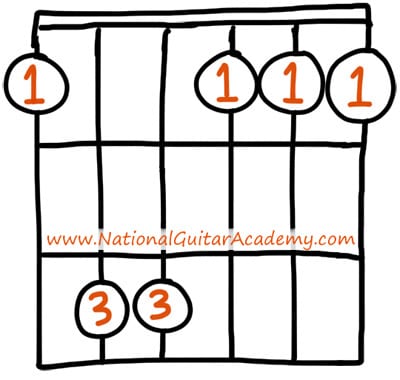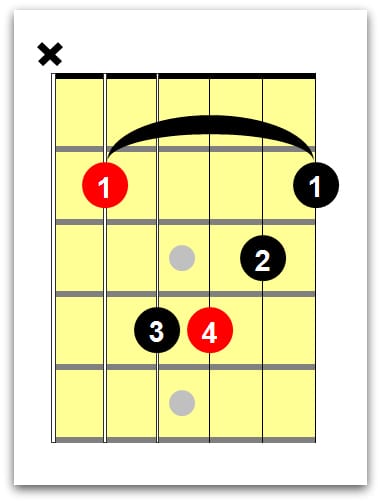There are 2 types of chords: ‘open chords’ and ‘barre chords’.
- Open chords – This should be your focus. These are chords that are played on the first 3 frets and are MUCH easier than barre chords.
- Barre chords – These chords require you to make a ‘barre’ and press down on the strings while also forming chord shapes with fingers 2,3 and 4.
FYI, here’s what a barre chord looks like:
Learn open chords first!
Ok, so we need to focus on OPEN CHORDS first.
Let’s look at which open chords you should learn and in what order.
Ok, here’s comes’ a big tip!
Learn chords in ‘batches’
The first batch of open chords you should learn are:
- Am.
- C.
- D.
- Em.
- G.
(These are the most common guitar chords of all.)
If you find a chord too difficult, you can always refer back to the stepping-stone version of each chord.
The best way to learn chords quickly is to follow our stepping-stone approach.
This is a proven method for quickly developing your finger dexterity and control while also allowing you to have fun and make music.
Our motto is ‘make things easy & fun’ and the stepping-stone chord system is a fundamental part of that philosophy.
The premise is very simple: there is an easy version of every chord.
As a beginner guitarist you should learn the easy version before you learn the harder standard version.
Let’s look at some examples:
As you can see the easier stepping-stone chord versions are simply different voicings of the original chords.
If you feel happy to tackle the standard versions then by all means begin with the standard versions, but most people find it much easier to use the stepping-stone version to get started. (Then after a few weeks you can move on to the standard chord versions.)
Batch 2
The next batch of chords you should learn are:
- A.
- E.
- F.
- Bm.
These chords crop up often, but not as frequently as the chords in batch 1.
As you can see, the standard chord versions are getting tougher. Check out those F and Bm chords. (Ouch!)
Stick with the stepping-stone versions here and you’ll be fine.
Batch 3
The final batch of chords you should learn are:
- B
- Dm
- Fm.
These chords appear less frequently, but they are still essential chords to know.
How do I practice these chords?
The best way to practice these chords is by playing songs that include them. To learn easy songs, go here: 10 Easy Songs On Guitar
However, if you prefer you can do ‘drills’ to really focus on building your muscle memory.
The secret to build muscle memory is to do things SLOWLY and CORRECTLY.
You will want to rush as your dexterity improves, but it’s vital that you don’t.
Sure, we want your overall speed to improve, but you will see how much more mistakes you make when you try to change too fast.
Push yourself, sure, but don’t forfeit your technique too much otherwise your accuracy will suffer.
Learning chord drills is a very mechanical way of learning how to play guitar.
It’s not the most enjoyable way to learn guitar chords, but some people prefer this.
What we want to do here is learn how to change from one chord to another
Some chords simply don’t crop up together (due to differences in key) so it’s not as simple as saying “practice changing from every chord to every other chord”.
No, that would be a waste of time!
So we’ve mapped out the most useful changes to help you learn guitar chords.
(It’s far more beneficial for your musicality to learn SONGS that you love. But some people like to have a clear program they can follow and that’s what will follow.)
Batch 1: Am, C, D, Em and G.
These chords frequently appear together, so we can literally practice these in any order and any sequence (and that will be valuable practice).
Practice each change 10 times before moving onto the next one.
- Am to C. (x 10.)
- Am to D. (x 10.)
- Am to Em. (x 10.)
- Am to G. (x 10.)
Then we can move onto changes that start with C.
- C to Am. (x 10.)
- C to D. (x 10.)
- C to Em. (x 10.)
- C to G. (x 10.)
Next, let’s look at some D changes.
- D to Am. (x 10.)
- D to C. (x 10.)
- D to Em. (x 10.)
- D to G. (x 10.)
Now some Em changes
- Em to Am. (x 10.)
- Em to C. (x 10.)
- Em to D. (x 10.)
- Em to G. (x 10.)
And finally some G changes.
- G to Am. (x 10.)
- G to C. (x 10.)
- G to D. (x 10.)
- G to Em. (x 10.)
Batch 2: A, E, F and Bm
We have to practice this batch differently because these chords aren’t in the same key. (Don’t worry about why right now!)
So there’s no point practicing these like we did with batch 1.
For this batch we need to mix it up; we’ll be blending chords from one batch to the next here.
These are the most common changes that you’ll encounter.
- A to E. (x 10.)
- E to A. (x 10.)
- F to C. (x 10.)
- F to G. (x 10.)
- C to F. (x 10.)
- G to F. (x 10.)
- G to Bm. (x 10.)
- Em to Bm. (x 10.)
- D to Bm. (x 10.)
- Bm to A. (x 10.)
- Bm to Em. (x 10.)
- Bm to G. (x 10.)
- Bm to D. (x 10.)
And finally we’re going to blend all three batches!
- B to E. (x 10.)
- B to A. (x 10.)
- E to B. (x 10.)
- A to B. (x 10.)
- Dm to F. (x 10.)
- Dm to C. (x 10.)
- Dm to G. (x 10.)
- F to Dm. (x 10.)
- C to Dm. (x 10.)
- G to Dm. (x 10.)
- Fm to Dm. (x 10.)
- Fm to C. (x 10.)
- C to Fm. (x 10.)
Want free guitar tips and video lessons delivered to your inbox?
Join over 250,000 guitar learners and subscribe to our guitar-tips-by-email service. (It's free.)
We'll send you a series of lessons that will move you to the next level of your guitar journey.
Learn how everything fits together quickly, easily and effectively. We share ninja tips (for instant fun!) but also timeless fundamentals that will deepen your understanding.
Our Guitar Courses
To become a better guitarist click here to see our guitar courses
Get your personalised guitar-learning plan 🎸
Want us to make a guitar-learning plan that is customised to you? Click here for GuitarMetrics™
Timing & rhythm when practicing chord changes
Because these chord transitions are so common it really doesn’t matter what timing you use to learn them.
It will all be muscle memory that you ‘put in the bank’ and will benefit from in the future.
However, here are a few tips and tricks which will help you master your timing.
- Stay on each chord for at least 8 beats.
This will give you time to make the chord change, tidy up any messy or buzzing strings, and prepare for the next chord change.
- A tempo of around 100-120 BPM would be perfect. But feel free to mix it up.
Use a metronome to set this and count the beats as you play.
We recommend the smartphone app ‘Metro Timer’. Give it a shot, it’s good.
You can also just google ‘metronome’.
Learn Guitar Chords | Barre Chords
One of the hardest chords you can learn is a barre chord.
Before you try and learn how to play barre chords, it’s essential that you know how to barre.
For 3 easy tips and tricks on how to learn barre chords, watch this video.
Barre Chords fall into two categories.
- E shape barre chords.
- A shape barre chords.
We refer to them like this because each barre chord is based on the open E and A chord shapes.
Here’s a classic E chord
Here’s an F barre chord (E shape)
Can you see how the shape of the chord is EXACTLY the same?
Here’s a classic A chord
Here’s a B barre chord (A Shape)
Notice how the B barre chord, uses the A shape.
The first barre chord we’re going to learn is the F chord.
- Barre your 1st finger from the 1st fret of the low E string (6th string) to the high E string. (1st string.)
- Place your 3rd finger on the 3rd fret of the A string. (5th string.)
- Place your 4th finger on the 3rd fret of the D string. (4th string.)
- Place your 1st finger on the 2nd fret of the G string. (3rd string.)
- Strum all the strings.
You can also play a minor version of this chord.
Fm Chord (E Shape)
- Barre your 1st finger from the 1st fret of the low E string (6th string) to the high E string. (1st string.)
- Place your 3rd finger on the 3rd fret of the A string. (5th string.)
- Place your 4th finger on the 3rd fret of the D string. (4th string.)
- Strum all the strings.
Now we’ve learnt how to play barre chords with an E shape, let’s learn some which use the A shape.
For this example, we’re going to learn the B barre chord and the B minor chord. Both of these barre chords use the A shape.
B Chord (A Shape)
- Barre over on the 2nd fret from the A string to the high E string. (1st string.) Use your first finger!
- Place your 2nd finger on the 4th fret of the D string. (4th string.)
- Place your 3rd finger on the 4th fret of the G string. (3rd string.)
- Place your 4th finger on the 4th fret of the B string. (2nd string.)
- Strum from the A string. (5th string.)
B Minor Chord (A Shape)
- Barre over on the 2nd fret from the A string to the high E string. (1st string). Use your first finger!
- Place your 3rd finger on the 4th fret of the D string. (4th string.)
- Place your 4th finger on the 4th fret of the G string. (3rd string.)
- Place your 1st finger on the 3rd fret of the B string. (2nd string.)
- Strum from the A string. (5th string.)
Moveable Shapes
One of the coolest thing about barre chords is that they are transferable shapes.
This means that you can get around 44 different chords out of 4 different chord shapes.
How do I do this?
To learn guitar chords around the fret board, you must know what the root note of a chord is.
The root note of a chord is the first note of a chord.
- For E shape barre chords, the root notes are on the E string. (6th string).
- For A shape barre chords, the root note is on the A string. (5th string).
To change the key of the chord, we must move it to a different root note/fret.
In order to do this, we must know what the root notes are on the E and A strings.
Here they are:
E String Root Notes
A String Root Notes
To change the key of your chord, move your barre chord to a different fret.
For example, to play an A barre chord:
- Move your E shape to the 5th fret.
- Move your A shape to the 12th fret.
Or if you wanted to play a D flat minor barre chord, you would either:
- Move your E shape barre chord to the 9th fret.
- Move your A shape barre to the 4th fret.
This trick works for both E and shapes with major and minor chords.
What about other chords?
There are hundreds and thousands of guitar chords.
Try and learn as many chords as possible as this enhances your musicality.
To learn advanced guitar chords, check out this lesson: Jazz Guitar: A 5-Step Programme For Rapid Jazz Skill
What Type of Guitarist Are You?
Take our 60-second quiz & get your results: Take The Quiz
Join the world's best online guitar school 🌎
- Get your own personalised guitar learning plan (customised just for YOU).
- World-class online guitar courses. Learn at your own pace.
- Community Campus & Learning Forum - A friendly community! Connect with our team & students. 😊
- Beginner Song library with chordsheets, tabs and tips. (Songs suitable for all levels!)
- Regular live streams, seminars and Q&A sessions - Learn from world-class guitar educators. Get all your questions answered!
Click here to learn more about National Guitar Academy membership 
Cool Guitar T-shirts 😎
Look cooler! Check out our merch: Click here to see our merch store
Want free guitar tips and video lessons delivered to your inbox?
Join over 250,000 other guitar learners and subscribe to our guitar-tips-by-email service. (It's free.)
We'll send you a series of lessons that will move you to the next level of your guitar journey.
Learn how everything fits together quickly, easily and effectively. We share ninja tips (for instant fun!) but also timeless fundamentals that will deepen your understanding.

Popular Lessons
How To Learn Guitar: An 11-Step Programme For Beginners
How To Choose The Perfect Beginner Guitar
More Cool Guitar Stuff
Learn about National Guitar Academy: About Us
Visit our YouTube channel for fun guitar videos.
Join us on Facebook for daily guitar tips.
Listen to our Learn Guitar Podcast for rapid guitar progress.
Check out our free chord lessons.
Get our best guitar tips & videos

